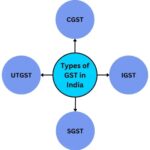The Goods and Services Tax (GST) has transformed the Indian taxation system by simplifying indirect taxes and bringing transparency to business transactions. For any product or service, the journey from manufacturer to consumer involves multiple stages, each of which is impacted by different types of GST. Understanding how these apply at each point in the supply chain is crucial for ensuring compliance and accurate pricing.
In this article, we break down the types of GST and how they affect various stages—from manufacturing to the final consumer.
Types of GST in India
India’s GST regime is a dual model, meaning it is administered both by the Central and State governments. The primary types of GST are:
-
CGST (Central Goods and Services Tax) – Collected by the Central Government on intra-state sales.
-
SGST (State Goods and Services Tax) – Collected by State Governments on intra-state sales.
-
IGST (Integrated Goods and Services Tax) – Collected by the Central Government on inter-state sales and imports.
-
UTGST (Union Territory Goods and Services Tax) – Applicable when a transaction takes place within a Union Territory without a legislature.
Let’s explore how these types of GST come into play throughout the supply chain.
Stage 1: Manufacturer to Wholesaler
When a manufacturer produces goods and sells them to a wholesaler within the same state, both CGST and SGST are applicable. For example, if a manufacturer in Maharashtra sells products to a wholesaler also in Maharashtra, the GST is split equally between the Centre and State.
-
GST Breakdown:
-
CGST: 9%
-
SGST: 9%
-
(Assuming total GST rate is 18%)
-
If the wholesaler is located in a different state, IGST is levied instead. So, for a sale from Maharashtra to Gujarat, 18% IGST is collected by the Central Government.
Stage 2: Wholesaler to Retailer
The same GST rules apply at this stage. If the wholesaler and retailer are in the same state, CGST + SGST are charged. If they are in different states, IGST is charged.
A critical factor here is Input Tax Credit (ITC). The wholesaler can claim ITC on the GST paid to the manufacturer, reducing the effective tax burden. This ensures that tax is only paid on the value addition at each stage.
Stage 3: Retailer to Consumer
This is the final point in the supply chain. The retailer charges GST to the end consumer based on their location.
-
If the sale is within the same state, CGST + SGST apply.
-
If the consumer is in another state, the retailer charges IGST.
It is important to note that consumers cannot claim ITC. They bear the final tax burden.
Compliance at Each Stage
Every business involved in the supply chain must register under GST and file returns regularly using proper accounting software, such as BUSY GST Accounting Software. This ensures:
-
Seamless ITC claims
-
Accurate billing and taxation
-
Transparency across transactions
BUSY Infotech Pvt. Ltd offers robust GST-compliant solutions that help manufacturers, wholesalers, and retailers manage tax obligations at each stage efficiently.
Conclusion
GST has streamlined the taxation process from manufacturer to consumer by clearly defining the types of GST applicable at each level. Whether it’s CGST, SGST, IGST, or UTGST, businesses must understand where and how these apply to avoid compliance issues and pricing errors.
With the right tools and knowledge, like those offered by BUSY Infotech Pvt. Ltd, navigating the complexities of GST becomes much simpler—empowering businesses to stay compliant and competitive in today’s dynamic market.

